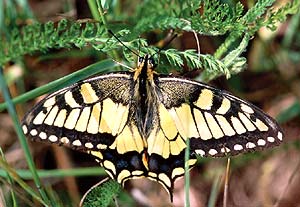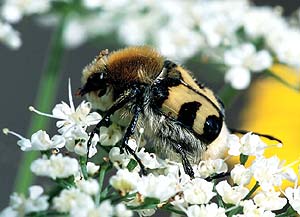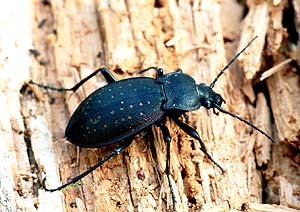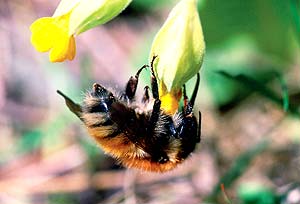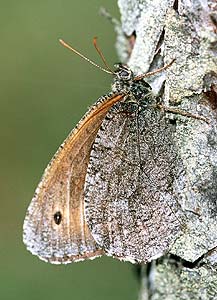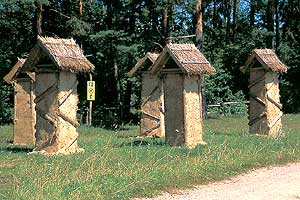|
TERRESTRIAL INSECTS
|
|||||||||||||||
Text:
|
Rare and protected species
The disappearance of numerous animal species, especially insects, has been increasing in rate for many years. It is estimated that a thousand of these taxa disappear every year, and probably the majority of them have never been described. Because of it, an efficient system for the protection of the fauna, especially species with extremely small population sizes is required. Rare species and species on the verge of extinction are recorded on various lists and are classified depending on the threat they are exposed to.
In Poland rare and threatened species are classified in the "Red Animal Book", "list of disappearing and threatened species" and the list of protected species published in the form of an ordinance by the Minister of Environment. Unfortunately, these lists do not include many rare vulnerable species and threatened ones. Insufficient knowledge about the distribution and population size of these animals and shortage of professionals specialising in some insect groups create great difficulties. Some insect groups are well studied, while others are less known. Beetles are one of the well studied groups. It is estimated from data collected in recent years that 40% of the insect species in Central Europe are threatened. Environmental degradation is the main cause of this situation.
Amongst the terrestrial insect species found so far in the area of the Wigry National Park, 101 species have been entered on national lists of threatened and protected species. These species represent only three orders: beetles (Coleoptera) (14 species), hymenopterans (Hymenoptera) (56 species) and butterflies and moths (Lepidoptera) (31 species).
In beetles, 2 species are listed in the Polish "Red Animal Book": the great capricorn beetle (Cerambyx cerdo) and the stag beetle (Lucanus cervus) have been given the status of species threatened with extinction, and partially disappearing (class V). In addition of these two species, there are 12 other beetle species, including 10 carabid beetles (Carabus) and one species each from the stag beetle family (Lucanidae) (the lesser stag beetle Dorcus parallelopipedus) and scarabids (Scarabaeidae) (a banded scarabid Trichius fasciatus) on the list of species covered by strict protection.
Ground beetles represent the most numerous protected species in the Park. In Poland, all species of this genus are under strict protection. These are large beetles occurring mainly in forested areas. The garden ground beetle (Carabus hortensis) is one of the most common beetles in the Park. It lives in forests, parks and gardens, where it hunts for snails and insects. It is active only at night, and it spends all the day hidden under stones, tree bark or in other shelters.
Other species are rare or only sporadically found in the Park. Amongst them, Trichius fasciatus deserves a special mention as it is one of the beetles featuring the most beautiful colours. The yellow and black pattern on its wing-covers is highly variable in appearance.
One species of hymenopterans – the small heath bumble-bee (Bombus jonellus) – was listed in the "Red Book" and given the status of protected species (R), 47 species have been placed on the "Red List" and 24 species (all bumble-bees) have been placed on the list of strictly protected species. Amongst the species from the "Red List", freely living bees prevail – 24 have been classified as rare, 13 species being threatened with extinction, 6 species were classified as vulnerable to general threat, while 1 species – the Schrenck’s bumble-bee (Bombus schrencki) was classified as in fact being extinct. More detailed studies conducted in the 90-s showed that the Schrenck’s bumble-bee is quite a numerous species, living in forests and their boundaries nearly all over Suwalszczyzna region.
Apart from bees from the "Red List", three ant species are classified as rare species: Myrmica sulcinodis was given the status of rare species whereas Harpagoxenus sublaevis and Camponotus vagus are listed as the species vulnerable to extinction. The sites of the latter species are northernmost stations in Poland.
Two butterfly species were listed in the "Red Book" as threatened with extinction. These are: the scarce swallowtail (Iphiclides podalirius) and the Baltic grayling (Oeneis jutta). 29 butterfly species were red-listed, and 7 species were placed on the protected species list. The Baltic grayling is the most threatened species whose station in the Park is one of three or four stations in Poland. These butterflies are closely connected with peat bogs, and cranberry, hare’s tail, sedges and bog bilberry are its main hosts.
The staff of the Wigry National Park take special care of rare and specially protected species, carrying out detailed studies on the status of the populations of these species in the Park, and by counteracting these threats by active protection. Building a clay and straw constructions being replacement habitats for several dozens of inspect species connected with clay buildings is such a measure. It applies especially to freely living bees and solitary wasps which are good examples of such action.
|
||||||||||||||
|
|
|
